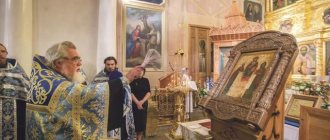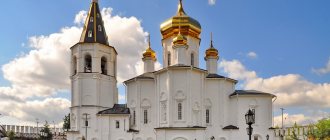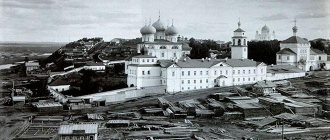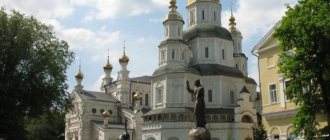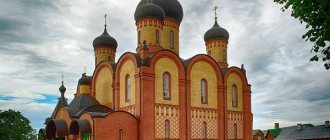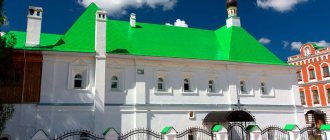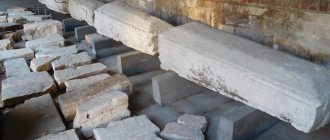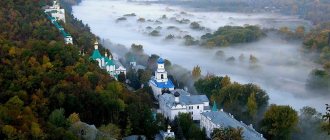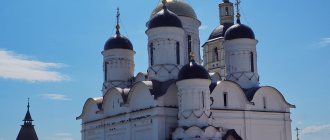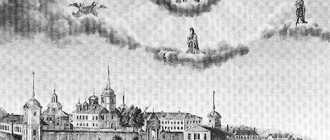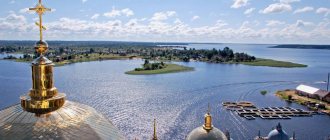Surrounded by the inaccessible Crimean mountains, not far from the city of Bakhchisarai, the unique active Holy Dormition Monastery is hidden in the gorge of St. Mary. The rocks around it are covered with greenery, dried in the hot Crimean sun, and they rise to a height of up to 140 meters. Only the most attentive tourist will notice among these mountains and vegetation the narrow stone paths, steep stairs and golden domes of the temple.
- Object status: active
- Date of foundation: end of the 8th century
- Age: 12 centuries
Three versions of the appearance of the monastery
The first version says that in 754, when the struggle against icons began in Byzantium, a church council was held, at which it was decided to equate prayers with idolatry, and the icons themselves with idols.
One brave monk named Michael decided to save the icon from the monastery. He wandered around the world for a long time and at some point ended up in Crimea. While resting near the gorge, the Virgin Mary came to him in a dream, she promised that the persecution would soon end, and that it was better for the monk to stay in this gorge. A few years later, in 780, all the prophecies came true. A monastery appeared in the gorge, and the persecution stopped.
The second version of the appearance of the monastery is also associated with a male shepherd named Mikhail. Every day he walked his herd in the gorge. One day he noticed a light and walked towards the light. Entering the cave, he noticed that the light was coming from the icon of the Virgin Mary.
Mikhail decided to pick up the icon and take it home. Waking up in the morning, he did not find the icon, he searched the whole house, all the buildings. Returning to the cave, I found an icon there. He took her home again, but in the morning he didn’t find her, returning to the cave, he found her there. And this went on several times.
After some time, Mikhail, after consulting with his comrades, decided to build a monastery in the gorge, and after a few years they had a whole cave city.
On August 15, the day of the celebration of the Dormition of the Mother of God, the first appearance of the icon took place. In honor of this event, the monastery received its name - Holy Dormition.
The third version says that in the old days, in these places there was a huge snake that mercilessly exterminated the livestock of the local population. People prayed to the Most Holy Theotokos for a long time to deliver them from the monster. One day, the peasants noticed a fire from a candle in the rock, but they could not reach it. I had to cut down steps to get to the candle. Having reached it, they saw an icon; a dead snake lay next to it. This is how the cave monastery appeared.
It is possible that this version only confirms that Christianity defeated paganism. It was in the Orthodox faith that the snake was associated with paganism. The face of a serpent can be found in images of St. George the Victorious or the Archangel Michael piercing the throat of a mammal.
Crimean Lavra. “A monastery is a place where people live in another dimension”
The Crimean Lavra is called the Holy Dormition Bakhchisarai Monastery near Bakhchisarai. Its roots go back to the hoary antiquity of Christianity. Today it is one of the largest monasteries on the peninsula, famous and visited. Since, due to the coronavirus pandemic, those pilgrims whose plans included getting to know the shrines of Crimea are forced to postpone their trips, we decided on the eve of the Feast of the Dormition of the Blessed Virgin Mary to talk about the Orthodox monastery located not far from the medieval capital of the Crimean Khanate. Bakhchisarai translated from Crimean Tatar sounds like this: “palace in the garden.” Or - “a palace surrounded by gardens.”
The revealed icon of the Mother of God was revered by Christians and Muslims
It was very sad to read on the Internet the confession of one Muscovite who last year visited Bakhchisarai on an excursion. She wrote that all church objects interest her only from an architectural point of view. And, having learned that women wearing trousers or shorts were prohibited from entering the monastery, she even calmed down. She decided to examine it “around the perimeter”, since most of all she wanted to see “Hamlet’s staircase”, on the steps of which Hamlet’s monologue “To be or not to be?” sounds. performed by Innokenty Smoktunovsky (Grigory Kozintsev’s film “Hamlet”, filmed in 1964). What can I say? That today there is an unplowed field before zealous Orthodox missionaries. If a person, being next to the greatest shrine, is indifferent to it and his heart is deaf to the Divine laws, this is both his and our misfortune... But one cannot help but rejoice at the other. A considerable number of people (some even come from far away) are sincerely interested in how the shoots of faith emerged in the holy place through the hard soil, obstacles, death threats and bloody reprisals against prayer books.
In the Holy Dormition Cave Monastery over the past centuries, all this also happened. But the miraculous appearance of the icon of the Mother of God helped the Christians of Taurida, who offered prayers to the Savior in the very center of Islam, to take root in their faith. The icon became the main shrine of the monastery - and it was also revered by Muslims (simple, as well as “high-ranking” - for example, the khan, who placed a pound of wax candle in front of the holy image on the eve of a military campaign). The icon has several names: Bakhchisaray, Panagia, Crimean Icon of the Mother of God and Mariupol. Various legends have reached us regarding the appearance of a miraculous image here. According to one of them, in the stone mountains a certain serpent devoured people and livestock. The Greeks and Genoese (these are Italians, who in the Middle Ages actively populated the Crimean Peninsula along the Black Sea coast) began to ask the Most Holy Theotokos to free them from the serpent. And somehow people saw a candle burning at the top, but the mountain was so steep that it turned out to be impossible to get there. Then they hewed steps out of stone and when they went up, they saw: a candle was burning in front of the image of the Mother of God. In addition, they saw a dead serpent: “they cut it into pieces, burned it with fire, and from that time the inhabitants there often began to walk there and pray to the Most Holy Theotokos” (from a folk tradition preserved for us by Russian writers of the 17th century).
Another legend connects this miracle with a shepherd named Michael. One day, Mikhail drove his flock to graze into the current Assumption ravine and saw on a rock, ten fathoms from the ground, an icon of the Mother of God, and in front of it a candle. When news of this reached the ears of the prince for whom Mikhail served, he ordered the icon to be moved to his house. Despite the reverence with which the owner received it, the next day the icon was not in the house - it returned to its original place on the rock. The same thing happened the second time. Then everyone understood that the Mother of God did not want Her holy image to be in a place other than the rock where it appeared. And they decided to build a small temple in the rock, opposite the place where the icon appeared. They carved out a cave inside the rock and a staircase to it outside. And the newly appeared icon was placed in the cave-temple. And the gorge was named Maryam-Dere - St. Mary’s Gorge.
The appearance of the miraculous icon in the 15th century occurred on the day of the celebration of the Dormition of the Mother of God, so the temple, carved into the rock massif, became the Assumption Church. And the story of the shrine has, let’s say, an unusual continuation, dating back to the 18th century, when almost all Christians left the Crimean Khanate. As usual, there is an abundance of speculation and distortion of facts. We will look at the explanation for this in the Life of St. Ignatius (Gazadini), an archpastor from Greece, who in 1769 headed the Gotthean-Kefai department in Tauris. The Life says: “For seven difficult years, Saint Ignatius ruled his see at this place, offering tearful prayers at the throne of God for the oppressed flock. Realizing the threat of spiritual and physical destruction looming over the Orthodox, he began negotiations with the Russian government and achieved the acceptance of Crimean Christians into Russian citizenship. After the Divine Liturgy, on April 23, 1778, in the cave church of the Holy Dormition Skete, he called on the faithful to begin preparations for the exodus from the country of slavery and humiliation. Messengers throughout the peninsula notified their co-religionists, and not a single traitor was found, thanks to which the Turkish-Tatar authorities of Crimea did not know anything about the impending event and were unable to prevent it. Leaving their homes and the graves of their ancestors, in the month of June, with the great shrine - the Bakhchisarai Icon of the Mother of God, they set out on the road. Lines of carts carried Christians away from the peninsula. The military side of the matter was led by Alexander Suvorov, and the spiritual and administrative side was led by Bishop Ignatius. More than thirty thousand people left the Turkish-Tatar Crimea. For his feat and courage, Empress Catherine awarded the saint a high award - the “diamond panagia.”
Lands were allocated for the settlers in the Azov province, but Metropolitan Ignatius turned to Count Potemkin with a request to allow people to settle further south, in the Pavlovsk district, since those lands did not satisfy them. And there, to the south, Mariupol was founded, which today is known as a city in the Donetsk region, one of the ten largest cities in Ukraine. And the Bakhchisarai icon, brought by the monks, was placed in a church specially built for it in honor of the Dormition of the Virgin Mary, and it became famous for its miracles. What happened to her after 1918 is unknown...
“What attracted you, brothers?”
Many believer historians and simply witnesses to events at different times noted that the mercy of the Most Holy Theotokos towards the region where the Bakhchisarai icon was revealed manifested itself even after the holy image left the Crimean peninsula. If you think about it: isn’t it the great mercy of the Queen of Heaven that one zealous archpastor saved the Christian population, taking it to a place where there was no intensity of religious intolerance and where a person professing the Orthodox faith could openly glorify Christ? Is it not thanks to Her intercession for the Crimean land that another zealous archpastor, another bright personality appeared here - Archbishop of Kherson and Tauride Innokenty (Borisov) - and took upon himself the work of restoring the Bakhchisarai monastery? We do not know the date of the founding of the ancient monastery near Bakhchisarai - whether it was founded in the 8th century by Greek monks who fled from Byzantium from persecution for venerating icons, or whether the first monks settled here in the 15th century. But as for the resumption of monastic life under Archbishop Innocent, the date is known: the opening of the monastery, which received the name of the Bakhchisarai Dormition Skete or Panagia, took place on August 15, 1850, on the day of the celebration of the Dormition of the Blessed Virgin Mary. By that time, Crimea was already Russian, and the monastery in the Maryam-Dere gorge soon again became the spiritual center of Crimean Orthodoxy.
Saint Innocent, a highly gifted scholar-theologian and preacher, was called the Russian Chrysostom, whose sermons were translated into Greek, French, German, Serbian, Armenian, and Polish. The heartfelt appeal of the Right Reverend to the large flock who had gathered on that memorable day to venerate the copy of the miraculous Bakhchisarai icon confirms his brilliant preaching gift. Here is a fragment from it: “Where are we and what are we doing? - asked the bishop. - Before us is a rock with its antediluvian, perhaps, top; behind us are the cliffs with their inaccessible heights; There are wilds and desert around us. And so many people and visitors flocked to this desert, to this rock and cliffs! What attracted you, brothers? They were obviously attracted by non-earthly motives and benefits: what is in this desert for them? Not the senses of flesh and blood: what food is there for them in these bare stones? And living faith in our Lord and Savior, whose most honorable and magnificent name is glorified in this place; attracted by living love to His Most Pure Mother, who, in Her wondrous icon from ancient years, chose this mountain as her home... Despite all the vicissitudes of time and circumstances, you continued to believe and love this holy mountain. And so the Lord heard your desire: your beloved place is restored to its ancient holy order and splendor.” After celebrating the Liturgy, the saint told those gathered a very important thing: when visiting this place, people will find in it not only prayer and worship, but also a way of monastic life according to the rite of Holy Mount Athos. “...we will have the consolation of seeing the likeness of ancient Athos,” said the bishop. Then an event occurred that, 170 years later, has not lost its significance. Several people in monastic clothing came forward from among the clergy and prostrated themselves before Archbishop Innocent, asking for his blessing to join the brethren of the Assumption Skete. Thus, the number of inhabitants of the newly built monastery unexpectedly increased...
Before this touching and symbolic moment there was another - also symbolic moment: the proclamation of many years to the most pious Sovereign Emperor and the entire August House, the Holy Synod, benefactors of the new monastery and all Orthodox Christians. On the throne was Nicholas I (remember: cruelly slandered by Western and Russian democrats, envious people and ill-wishers. But those who “dug deep” into history - deeply and impartially, found a lot of valuable evidence that Nicholas I felt his reign as the fulfillment of the duty of the Anointed One before God). For the brethren of the current monastery, as well as for their predecessors, it is important that this holy place was visited by royal and princely persons in different eras, starting, by the way, with Catherine II, who allowed Orthodox Greeks to move to Russia along with Metropolitan Ignatius. The wife of Nicholas I, Empress Alexandra Feodorovna, was also in the monastery. Their eldest son was Emperor Alexander II, the Tsar Liberator, whose great merit was the liberation of peasants from serfdom. Tsar-Martyr Nicholas II visited the monastery several times. The last time was on August 30, 1913. The list of the highest persons who to some extent patronized the monastery is considerable. Their names with portraits can be seen on the official website of the monastery in the “Guests” section.
“A monastery is a place where people live in another dimension”
During a visit to one of the monasteries, speaking about the miracle of the return of shrines from oblivion and the construction of new churches across the Russian land, His Holiness Patriarch Kirill emphasized that although miracles in our lives are the result of Divine action, nevertheless, they always include human factor. Because water does not flow under a lying stone. The monastery near Bakhchisarai, destroyed during the Soviet era, began to be revived in 1992, when Metropolitan (then Archbishop) Lazar of Simferopol and Crimea served the Divine Liturgy in the cave church and consecrated the source. Father Silouan (Makei), appointed abbot of the monastery, arrived from the Odessa monastery, and according to the testimony of parishioners, the cave Church of the Holy Assumption was very quickly restored, the belfry was rebuilt, cells and some outbuildings were restored, a cave church in the name of the holy Apostle and Evangelist Mark, Church in the name of Saints Equal-to-the-Apostles Constantine and Helena. The rock iconography above the balcony of the Assumption Church was also restored. A hotel for pilgrims, craft workshops, and premises for livestock appeared.
Yes, a lot has been done! Through the efforts of the governor, the brethren, and the pious laity, the monastery changed beyond recognition. Hieromonk Avvakum (Gubanov), (now an archimandrite), recalls the difficult beginning in the documentary film “Crimean Athos (Crimean Lavra)”. According to the priest, there were days when it seemed that nothing would be built here - the inhabitants would be kicked out of here and everything here would freeze and die. But a time of some kind of numbness, despondency, and to some extent panic passed, and construction resumed. “Father Silouan knows this best of all,” Father Avvakum continued, “because he has all the control levers in his hands. He is the abbot, he is the heart of the monastery. He holds both the construction site and us in his hands. I am very grateful to him, because this man is like a mother, like a father to us all. At least that's how I perceive it. I know that this is my boss from God and the will of God, through the mind and heart of Father Silouan, descends on me and moves me.”
It was extremely difficult to restore the monastery, not only because of the terrible destruction and difficult economic situation. Tracking sympathetic publications in the media (there are also plenty of slanderous ones on this issue), you see: despite the peacetime, the brethren had to really hold the line. Serious threats came from representatives of the Majlis of the Crimean Tatar people. It was later, in 2016, that the Supreme Court of Crimea recognized this organization as an extremist public association and banned its activities in Russia, and a few months later the Supreme Court of the Russian Federation finally recognized the ban on the activities of the Mejlis of the Crimean Tatars in Russia as legal. But in the summer of 2001, its leaders gathered Tatars from all over the peninsula in the square in front of the entrance to the Holy Dormition Monastery and staged a stormy protest rally against the return of the monastery to its historical lands. Although the territory of the pan-Christian shrine is well known from numerous documents, photographs, diagrams, moreover, the state act for land acquisition was issued only after enormous preliminary work with the archives of Crimea, Kiev, Moscow, but the Mejlis activists and the people provoked by them into hostile actions did not want anything hear. The situation escalated to such an extent that they had to call in the special forces unit of the Berkut special police unit.
Aggression towards the monastery manifested itself in various forms in subsequent years. The leaders of the Majlis eventually decided to translate their insistent demand to transfer part of the monastery land to a market for Crimean Tatar entrepreneurs into a practical plane. In the spring of 2004, a group of militants, armed with crowbars and crowbars, began to destroy temporary shelters for pilgrims to rest, installed by the brethren. Then, with the support of local authorities, the Tatars erected trading tents in the place where the canopies had previously stood. Taking advantage of the fact that the monastery is visited by thousands of tourists, merchants began to quickly offer them souvenirs, scarves, jewelry, etc., etc., not allowing people to break away from worldly temptations, but, on the contrary, dragging them into the noisy bustle. Another fact from the “bitter chronicle of confrontation”: at the beginning of 2007, a meeting was held in the Bakhchisarai district state administration headed by the chairman of the city administration, Ilmi Umerov. Yes, with the same one who was tried in 2022 as the deputy chairman of the Crimean Tatar Mejlis banned in the Russian Federation and found guilty of extremism and public calls for violating the territorial integrity of the Russian Federation. However, at that time he still felt like a sovereign master, and the Orthodox monastery under the rocky arches was of interest to Umerov only in terms of taking away a significant part of its historical territory.
At a meeting in the district administration, the abbot of the monastery, Archimandrite Silouan, made a reasoned speech - he so clearly outlined the true state of affairs and firmly outlined his position that, it would seem, the land issue can be closed once and for all. (Unfortunately, this did not happen.) Turning to the realities of the past, Father Silouan then noted that not a single historical document contains information that the khans demanded that the monastery be removed and its land taken away. Citing examples of warm and friendly relations between Christians and Muslims, the priest recalled an eloquent fact dating back to the not-so-distant 19th century. Revered and respected by all Crimean Tatars, the famous writer, poet, public figure Ismail Bey Gasprinsky, during his time as the mayor of Bakhchisarai (1878-1883), repeatedly greeted with bread and salt the bishops who visited the city and the monastery. Literally point by point, the father-vicar suggested reasonable ways to resolve painful issues and then addressed those gathered with the words: “I believe that in this way we will begin to restore the peace, tranquility and harmony that existed between the monastery, its governors and the khans before 1917, when none of them had any complaints against each other for any reason, but there was peace, advice and love.” To live in harmony with people of other faiths and in love for the Fatherland - the brethren sincerely pray for this.
...In the above-mentioned film “Crimean Athos (Crimean Lavra),” the monastery’s resident, Father Avvakum, pronounces words that are important not only for monastics. It would be nice for each of us to imprint them in our hearts. “A monastery is a place where people live in another dimension,” says the priest. But it is with this understanding that we must enter the monastery fence. And with great respect - for the strict order of monastic life and prayerful concentration, which cannot be disturbed by noise, laughter, or extraneous conversations. Monks carry out their feat of prayer and work, but we must also mentally prepare ourselves for the fact that visiting a monastery - one or several - will require the mobilization of all forces, and only then can the sharpness of spiritual hearing and the fullness of vision appear, and as the greatest reward - the feeling of the presence of a special grace. I will give a touching, almost poetic comparison, taken from a publication on the website “Crimean Lavra. Holy Dormition Monastery": "...this holy place must be treated with reverence, just like a transparent snowflake, which, if you grab it with your hand, will turn into only a drop of a tear."
Without a feeling of sacred awe, it is hardly worth going to where, according to the inhabitant of the ancient cave monastery, the sky touches the earth. Not the physical sky, emphasized Father Avvakum, but the spiritual one.
Photo by Vladimir Khodakov and Ekaterina Orlova Also provided are images from the public domain
Historical reference
The early history of the monastery and its origins are a real blank spot. Before the 14th century there is practically no information about him. The only known fact is that in the 13th century the monastery was closed, and for 100 years it was completely abandoned.
In the 14th century, thanks to the efforts of the princes of Moscow, the cave monastery was revived. The monastery received generous alms from the center of Rus', but still remained in a deplorable state.
An interesting fact is that in 1457, during the Ottoman conquest of Taurida, the monastery was not damaged. Since the 15th century, the monastery has been the residence of the Gothic metropolitans.
The period of development of the monastery occurred in the middle of the 19th century. 5 temples, buildings for monks and houses for pilgrims appeared on the territory of the complex. A magnificent garden was planted around it.
During the Crimean War, the monastery played the role of a hospital. 170 officers and soldiers are buried in the monastery cemetery.
During the Soviet period, from 1921, the monastery was closed. All novices and monks were shot, and valuables disappeared.
During the Second World War, the monastery again became a hospital, and after it ended, a psychoneurological dispensary was opened within its walls.
Only in 1993, the monastery received a “second wind” and was restored.
History of the monastery to the present day
The Assumption Monastery for Men is hidden under rocky arches and looks like a magnificent cave palace. It is located in the middle of Mariam-Dere, a gorge, next to the city of Bakhchisarai. The temple is surrounded by steep walls 1.5 meters high. The monastery was often called “Lavra” and even khans who professed Islam came at night to the icon of the Mother of God to receive blessings.
The history of the temple dates back to approximately the 13th century, when it closed for 100 years. The monastery was saved by financial injections from the Moscow princes. Thanks to this, the temple “rose from the ashes,” although it eked out a miserable existence. When Taurida was captured by the Tatar horde in 1475, the monastery was not destroyed and many (including ambassadors) came to worship.
A little-known attraction of Crimea - Lake Ai-Efim -
Then the monastery was a stronghold of the Gothic metropolitans for decades. Many Crimean khans visited the monastery, and the head of the Giray dynasty even provided the temple with candles for the whole year. At the end of the 15th century. Crimea was captured by the Ottomans and demanded tribute for holding religious services. In the 18th century The lands passed to the Russian army, and the new authorities ordered the monks to move from the cave temple to Mariupol. The image of the Mother of God also went with them.
The Greek holy father K. Spirandi began guarding the empty monastery. A new shrine also arrived with it - a unique icon of the Dormition of the Virgin Mary. Worship services have resumed. Then a new monastery appeared in Bakhchisarai, where many parishioners moved.
The cave temple was closed again. Its revival began only in the mid-19th century, restoration work began in 1850. Ordinary people actively helped the monks. As a result, bells, images, and utensils for worship were purchased. In a short time, the temple began to function at full capacity again.
It was then ruled by Archimandrite Polycarp. In 1818, Alexander I visited the temple, kissed the icon of the Mother of God and lit a candle. Nicholas I and II, Alexander II also visited the monastery. After the start of the Crimean War, the church housed a hospital where the wounded were nursed.
The subsequent restoration of the temple continued for many years. New buildings and buildings appeared. The Church of the Assumption has found “new life”. The monastery was supplemented with 3 tiers, 11 cells, a bell tower, and a house for the abbot of the monastery. A bakery, hotels for guests, outbuildings, a kitchen and a dining room were built. They even restored the water supply system, which took water from an underground spring.
After the end of the revolution and the massacre of the royal family, the temple was closed (starting in 1921), looted, and the monks were shot. On the site of the monastery, the Labor Colony named after. Artem. The stoves were heated with priceless church volumes. In 1925, believers turned to the Soviet authorities with a request to give them ancient monastery items for safekeeping. As a result, some of the icons were saved and sent to the Bakhchisaray museum.
In 1927 there was a strong earthquake that destroyed many buildings. Only the Assumption Church remained intact. Before the Great Patriotic War, the destroyed temple remained uninhabited, and then it was again converted into a soldier’s hospital. Afterwards, a psychoneurological clinic settled in it.
The next revival of the temple took place in 1993. Odessa hieromonk Silouan became the rector. He set about restoring the cave temple. Money was collected “by the whole world.” Pilgrims contributed most of it. They also came to work physically. As a result, the Church of the Assumption, the steps to the monastic cells, and the painting under the balcony were restored. New church bells were donated to the temple by a metallurgical plant in Dneprodzerzhinsk.
Description
The main building of the complex is the Holy Assumption Church, erected on the site of the appearance of the miraculous icon of the Mother of God. She seems to be hanging over a cliff. It has a rectangular shape. In front of the church there is a small bell tower with a 58-pound bell.
You can get to it via a wide but high staircase (83 steps). It is not new, but completely restored.
There is a high fence along the stairs. It displays images of the planet’s holy places.
Opposite the church there are outbuildings and monastic cells. They are all carved into the rock and covered with white plaster.
The Gethsemane chapel and fountain are located near the bottom flight of stairs to the temple. They were erected in 1867. Previously, the chapel was located in a garden; only a few trees remain.
Today the monastery is open to absolutely everyone. But all visitors are required to adhere to church canons. Men are not allowed to visit in shorts, and women must wear skirts and headscarves.
The monastery complex is a three-part monastery:
- Top floor. There are 3 churches on it: the Assumption, the Holy Equal to the Apostles Kings and the Holy Evangelist Mark, a bell tower and 13 cells.
- Middle floor. On this platform there is only one church - Innokentyevskaya, a fountain and 3 cells in the rock.
- Ground floor. There are 2 living rooms, service premises and a refectory building, two fountains and the holy gates.
On the left side of the rock there is a cemetery and St. George's Church.
The entire cave city is surrounded by lush greenery, home to many birds. Not far from the monastery, on the south side you can see an orchard.
Bakhchisarai miraculous icon of the Mother of God
This ancient Byzantine icon has been in the monastery since the 17th century. It became famous for its miraculous effects during the cholera epidemic in 1848. The icon is also credited with interceding for the city in 1855 and saving it from the Anglo-French squadron. There are other miracle-working icons that are preserved in the records of the Kherson spiritual consistory. At the beginning of the 20th century, the icon of the Mother of God became very dilapidated. The last mention of her fate dates back to 1918. Nowadays, copies of the miraculous icon are kept in the monastery.
Monastery temples
There are only 5 temples on the territory of the cave city.
The church in the name of the Holy Apostle and Evangelist Mark, located slightly below the Assumption Church, is also carved into the rock. It appeared in 1859. A little higher than the church, there is a library and sacristy in the rock.
The temple in the name of the holy Equal-to-the-Apostles Kings Constantine and Helena was erected in 1857, under a rock. Not far from it are the ashes of Berkova, a great benefactor of the Crimean peninsula.
The Church of St. George the Victorious was erected on a military cemetery in honor of the soldiers who laid down their lives for Russia during the Crimean War.
On the middle platform of the monastery stands another cathedral in the name of St. Innocent of Irkutsk.
Current state of the monastery
The monastery is located in the Mariampol Gorge of the Crimean Mountains. It is considered the main shrine of the entire Crimean peninsula. The church belongs to the Simferopol and Crimean diocese of the Ukrainian Orthodox Church of the Moscow Patriarchate. The rector of the temple is Archimandrite Silouan.
On the territory of the monastery there are two cemeteries - for soldiers of the Great Patriotic War and for soldiers of the Crimean Company.
More on the topic: The wondrous monastery of Florishcheva Monastery, what will a pilgrim remember about it?
In the church there is a copy of the miraculous icon of the Mother of God “Hodegetria of Mariampol”. It is located in a grotto carved into the main temple of the monastery.
Today, the monastery is functioning, pilgrims visit it, excursions are held, but restoration work is still underway.
Other buildings of the monastery
On the middle platform near the temple there is a rector's house, built in 1862. Inside the house there is a refectory, 6 cells for monks and a kitchen with a bakery.
Under the rock there are 16 more rock-cut cells and two free-standing ones. In one of the rock cells there is a prosphora. The cells themselves are poorly adapted for permanent residence; the humidity there is very high.
For visiting pilgrims, a 2-story stone building was erected in the lower part of the monastery complex.
When leaving directly from the city there are gates with cells.
Literally 1 km from the monastery there is a natural rock spring with spring water. The depth of the well is about 4 meters. In 1896, a water supply was laid from this source to the monastery.
At a short distance from the well, a pool was erected, on the front side of which there is an icon of the Dormition of the Mother of God and a stone cross.
Legends associated with the monastery
Three legends are associated with the Assumption Lavra.
- At the site of the monastery, the shepherd Michael found an icon of the Mother of God. After the icon was transferred to a new place, it returned to the rocks again. Then the villagers realized that a temple should be built here. The miracle occurred on August 15, on the Dormition of the Blessed Virgin Mary, so the temple was named Assumption.
- In ancient times, the inhabitants of Crimea were attacked by a predatory serpent. People turned to the Mother of God in prayer and asked her for help. After some time, they noticed a burning candle on the rock. Having cut a road to it, people saw an icon of the Mother of God and a dead serpent. The Assumption Lavra was built on the site of the miraculous phenomenon.
- The icon was transferred from a temple located in Byzantium, near the city of Trebizond.
IMPORTANT INFORMATION. The appearance of pilgrims must correspond to the theme of the trip. Open and short clothing is not appropriate. Women should wear a headscarf before entering the monastery.
Interesting Facts
On the stairs of the monastery, footage from the film “Hamlet” was filmed; it is in them that the main character pronounces part of his most famous monologue “To be or not to be.”
At different periods of its existence, the monastery had different names: Crimean Lavra, cave city, cave monastery, monastery of the valley of St. Mary.
The caves of the monastery have amazing acoustics. Even if there are a lot of people on the site in front of the cave and they are making noise, then you just need to go inside and the noise will immediately disappear completely. This is due to the fact that porous Crimean limestone intensively absorbs almost any noise.
The monastery was visited by imperial persons: Alexander I, II and Nicholas I.
The researchers came to an interesting conclusion. The monastery is located as if on the border of two worlds between Christian and pagan. Christian burial grounds from the 6th century were found not far from the monastery. They are, albeit indirect, but still proof that since ancient times there were Christian settlements here that needed churches for worship. Nearby there were Alan-Gothic settlements (pagan), to which the monks (Monks) of the monastery brought Christianity.
Legends about the founding of the monastery
Reliable information about how and when the monastery was founded is unknown. There are many legends surrounding the history of the construction of the shrine. One of them tells about the shepherd Mikhail, who every day grazed a flock of sheep in the mountains. One day he saw a strange glow emanating from a cave near the pasture. Looking inside, the guy discovered the image of the Virgin Mary, shrouded in bright light. The shepherd brought the icon home, but the next morning it disappeared. Imagine his surprise when he saw her again in the same cave. The boy took the shrine with him again and history repeated itself. The residents of the village where Michael lived, who learned about this, interpreted the unusual incident as a divine sign, and soon together they built a cave temple at the site of the discovery of the Holy Face.
Holy Dormition Cave Monastery near Bakhchisarai
Another myth associated with the Holy Dormition Monastery speaks of an evil dragon who got into the habit of destroying young boys and girls. Desperate fellow villagers appealed to the Most Holy Theotokos, begging Her for deliverance from the bloodthirsty serpent. After some time, the tragic deaths stopped. The emboldened villagers climbed the mountain, where they found the defeated reptile, above whom the shining image of the Mother of God hovered. To honor the Heavenly Intercessor, they built a church in the rock, where they began to come to offer prayers of thanks.
The most plausible is the legend about the Greek monks who, during Christian persecution, moved to the Crimean peninsula. Looking for a new refuge, they were captivated by the beauty of the Maryam-dere gorge, so similar to their native places. There they built a temple, and soon founded a small settlement. Later, archaeologists discovered ancient burials on the territory of the monastery, dating back to the 6th century, which gave this version even more plausibility.
How to get there
Bus No. 2 runs from the Bakhchisarai railway station. You should get off at the Staroselye stop. From the stop you can get to the monastery along a path that runs along the picturesque Maryam-Dere gully. You need to go from a former settlement called Staroselye. The path begins immediately after the bridge over Churuk-Sud. The road runs along a rocky path with a noticeable rise. On the right there is a view of the boulders, on the left there is a cliff.
The view of the monastery opens unexpectedly after 0.5 km of the journey. The Assumption Church in the rock is immediately visible.
You can walk to the monastery from the Khan's Palace in literally 30 minutes. It is a narrow road with signs along a picturesque landscape. There are ancient tombstones and caves along the way.
You can get to the monastery by personal vehicle. In front of Bakhchisarai, on the roundabout, if you are coming from Simferopol, after a couple of minutes you need to turn left. There is a sign at the turn, about 2.5 km to the monastery. You need to follow the bypass road for about 5 minutes, turn left near the Khan's Palace and move to the village of Staroselye. Further only on foot along the path.
Address: Bakhchisaray, st. Mariampol, 1. GPS coordinates: 44.7449311074355, 33.9100376050919.
Tips for visiting the monastery
The Holy Dormition Monastery is an Orthodox shrine, and therefore one should behave on its territory in accordance with the church charter. A few rules to help avoid unpleasant situations:
- Photography or video shooting is prohibited;
- mobile phones should be switched to silent mode or turned off;
- women must cover their heads and wear modest attire.
You can take memorable photos only with the permission of the abbot and pay a symbolic donation to the monastery.
Author's advice
You can stay for several days in the guest house, which is located here. At the same time, food and accommodation are free. In return, the pilgrim is required to help with the housework, as well as adherence to local regulations.
Video filming is prohibited on site
Mobile phones should be turned off
A woman must cover her head before entering
The Holy Dormition Monastery is a picturesque place among the Crimean mountains, where pilgrims from all over Russia strive to get to. People come here to look at the local beauty, pray to the miraculous icon and simply pay tribute to the great history of this shrine.
If you find an error, please select a piece of text and press Ctrl+Enter.
Holy Dormition Cave Monastery on the map, GPS coordinates:
A visit to the Holy Dormition Cave Monastery in Bakhchisarai will appeal not only to believers and pilgrims.
But also for everyone who appreciates history, ancient architectural monuments and unique buildings. Don't discount the beautiful landscapes. Have a pleasant, most interesting holiday! Stanislav recommends:
- Where to relax in January
- Where to relax in February
- Where to relax in March
- Where to relax in April
- Where to relax in May
- Where to relax in June
- Where to relax in July
- Where to relax in August
- Where to relax in September
- Where to relax in October
- Where to relax in November
- Where to relax in December
Temples[edit]
See the list of all temples in Bakhchisarai HERE
.
Temple of the Feodorovskaya Icon of the Mother of God (Bakhchisarai)[edit]
The Temple of the Feodorovskaya Icon of the Mother of God in Bakhchisarai was consecrated in honor of the family image of the Romanov family. The temple is not one of the ancient shrines, but has already celebrated a significant anniversary - 100 years.
Address:
Russia, Republic of Crimea, Bakhchisaray district, Bakhchisaray, st. Makedonskogo, 2
The church is located in the western part of the city, not far from the Bakhchisarai railway station, the city administration and the House of the merchant Dmitry Pachadzhi.
Directions:
The most convenient way to get to the church is by minibuses No. 2 and No. 3, get off at the Dom Byta stop. Then walk a few tens of meters to the northwest.
Chapel of the Archangel Michael (Bakhchisarai)[edit]
The Chapel of Michael the Archangel in the Russian Settlement of Bakhchisarai is a monument to the glorious heroes of the Crimean War.
During this war, the dead and those who died from wounds were buried near the old Armenian cemetery.
A brotherly cemetery was built here and about 4 thousand Russian soldiers were buried.
Since that time, this area of the city has been called Russkaya Slobodka.
Currently the chapel is not operational.
Address:
Bakhchisaray, st. Pushkina, 42a
Church of St. Nicholas the Wonderworker (Bakhchisarai)[edit]
This temple is a continuation of the history of St. Nicholas Cathedral, built in 1798 (1799) by the Greek diaspora. During the war, the cathedral was destroyed.
After this, a living space was adapted for the temple, which dates back approximately from the late 40s of the 20th century to the present day.
Over the years, the Church of St. Nicholas has become a home not only for the residents of Bakhchisarai, but also for many residents of Sevastopol and other villages who continue to come here to pray, be baptized, and get married.
Temple opening hours: daily from 9:00 to 16:00
Address
: Republic of Crimea, city of Bakhchisaray, Komsomoltsev-underground workers street, 9.
